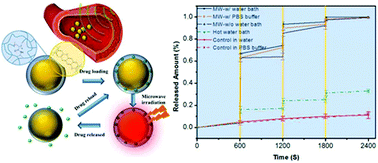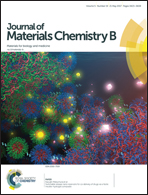Microwave-responsive polymeric core–shell microcarriers for high-efficiency controlled drug release†
Abstract
High-efficiency, targeted drug release systems are of great importance in medical science and have drawn significant research attention in the past few decades. Although microwave irradiation has been demonstrated as a promising external drug release trigger owing to its advantageous features including noninvasiveness, high thermal efficiency, and ability to penetrate deep into the body; a drug carrier system which can receive microwave signals and actively control drug release is still needed. Here we designed a first-of-its-kind microwave-sensitive polymeric drug microcarrier based on poly(p-phenylenediamine) (PpPD)/poly(N-isopropylacrylamide) (PNIPAM) core–shell structured particles for controlled drug release with exceptional high efficiency. The PpPD particle core could absorb microwave irradiation and convert the electromagnetic radiation to thermal energy, thus actively heating up the PNIPAM shell. Meanwhile the PNIPAM shell could store drug molecules and burst release them when heated, achieving an efficient self-actuating behavior for drug release. The controlled release tests for folic acid and etoposide demonstrated that the core–shell polymeric system serves as a general drug carrier for highly efficient microwave-triggered controlled drug release.



 Please wait while we load your content...
Please wait while we load your content...